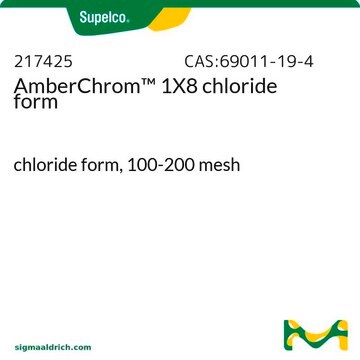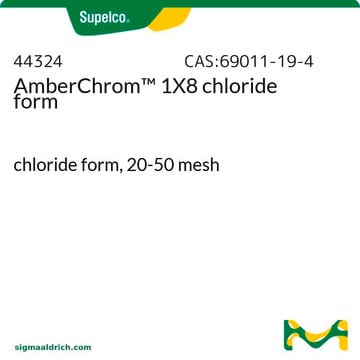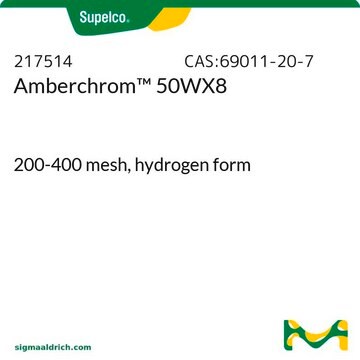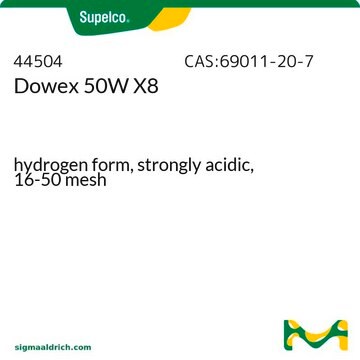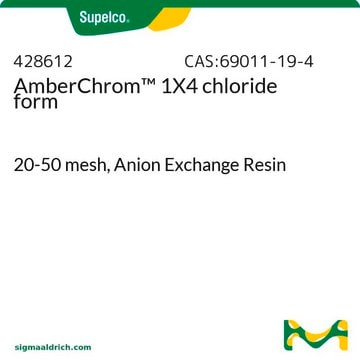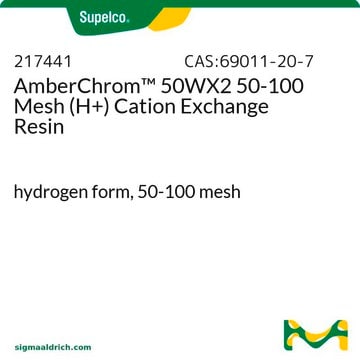217417
AmberChrom™ 1X8 Ion Exchange Resin
chloride form, 50-100 mesh
Sinônimo(s):
AmberChrom™ 1X8 chloride form, AmberChrom™ 1X8-100 ion exchange resin
About This Item
Produtos recomendados
product name
AmberChrom™ 1X8 50-100 MESH (CL-) Anion,
descrição
cross-linkage 8%
Nível de qualidade
forma
beads
reticulação
8 % cross-linked
Parâmetros
66 °C OH- form max. temp.
umidade
43-48%
técnica(s)
LPLC: suitable
matriz
styrene-divinylbenzene (gel)
Grupo ativo da matriz
quaternary ammonium
tamanho de partícula
50-100 mesh
pH operacional
0-14
capacidade
1.2 meq/mL by wetted bed volume
técnica de separação
anion exchange
InChI
1S/C10H12.C10H10.C8H8.C3H9N/c2*1-3-9-7-5-6-8-10(9)4-2;1-2-8-6-4-3-5-7-8;1-4(2)3/h3,5-8H,1,4H2,2H3;3-8H,1-2H2;2-7H,1H2;1-3H3
chave InChI
HADXLRSCRPYPJJ-UHFFFAOYSA-N
Procurando produtos similares? Visita Guia de comparação de produtos
Categorias relacionadas
Descrição geral
Aplicação
- to separate the 3H2O from D[2-3H] glucose using Dowex columns
- in a assay to determine the pantothenate kinase using Dowex column.
- to separate inositol phosphates (IPs) from myo-[3H]inositol by Dowex chromatography.
Características e benefícios
Outras notas
Informações legais
Código de classe de armazenamento
11 - Combustible Solids
Classe de risco de água (WGK)
WGK 2
Ponto de fulgor (°F)
Not applicable
Ponto de fulgor (°C)
Not applicable
Equipamento de proteção individual
Eyeshields, Gloves, type N95 (US)
Choose from one of the most recent versions:
Já possui este produto?
Encontre a documentação dos produtos que você adquiriu recentemente na biblioteca de documentos.
Os clientes também visualizaram
Conteúdo relacionado
A cromatografia líquida de baixa pressão (LPLC) é uma técnica cromatográfica que opera com baixas pressões para impulsionar a fase móvel para a coluna que contém uma fase estacionária por meio da ação de uma bomba.
Low pressure liquid chromatography (LPLC) operates at low pressures, using a pump to drive the mobile phase onto the column.
Nossa equipe de cientistas tem experiência em todas as áreas de pesquisa, incluindo Life Sciences, ciência de materiais, síntese química, cromatografia, química analítica e muitas outras.
Entre em contato com a assistência técnica